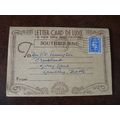Vlaminck, Maurice - Sailing Boat - art postcard (Medici)
- Condition : Used
- Dispatch : 2 Days
- Brand : None
- ID# : 200614554
- Quantity : 1 item
- Views : 256
- Location : United Kingdom

- Seller : justthebook (+1703)
- Barcode : None
- Start : Mon 03 May 2021 06:30:48 (EDT)
- Close : Run Until Sold
- Remain : Run Until Sold
Checks/Cheques
 for 1 item(s) edit
for 1 item(s) edit
Shipping Calculator
More Listings from This Seller view all
Seller's Description
- Art Postcard
- Work of art title: Sailing Boat
- Artist (if known): Maurice Vlaminck
- Media or other details: painting
- Publisher / Gallery: Marlborough Fine Art / Medici Society, London
- Postally used: no
- Stamp & postmark details (if relevant):
- Size: Modern
- Notes & condition details:
NOTES:
Size: 'Modern' is usually around 6in x 4in or larger / 'Old Standard' is usually around 5½in x 3½in. Larger sizes mentioned, but if you need to know the exact size please ask as this can vary.
All postcards are not totally new and are pre-owned. It's inevitable that older cards may show signs of ageing and use, particularly if sent through the post. Any faults other than normal ageing are noted.
Stock No.: A1244
Please ask if you need any other information and I will do the best I can to answer.
------------------------------------------------
Postage and packing charge should be showing for your location (contact if not sure).
UK - PayPal, Cheque (from UK bank) or postal order
I will give a full refund if you are not fully satisfied with the postcard.
----------------------------------------------
Maurice de Vlaminck (4 April 1876 – 11 October 1958) was a French painter. Along with André Derain and Henri Matisse he is considered one of the principal figures in the Fauve movement, a group of modern artists who from 1904 to 1908 were united in their use of intense colour.[1] Vlaminck was one of the Fauves at the controversial Salon d'Automne exhibition of 1905.
Maurice de Vlaminck was born on Rue Pierre Lescot in Paris. His father Edmond Julien was Flemish and taught violin and his mother Joséphine Caroline Grillet came from Lorraine and taught piano.[2] His father taught him to play the violin.[3] He began painting in his late teens. In 1893, he studied with a painter named Henri Rigalon on the Île de Chatou.[4] In 1894 he married Suzanne Berly. The turning point in his life was a chance meeting on the train to Paris towards the end of his stint in the army. Vlaminck, then 23, met an aspiring artist, André Derain, with whom he struck up a lifelong friendship.[3] When Vlaminck completed his army service in 1900, the two rented a studio together, the Maison Levanneur, which now houses the Cneai,[5] for a year before Derain left to do his own military service.[3] In 1902 and 1903 he wrote several mildly pornographic novels illustrated by Derain.[6] He painted during the day and earned his livelihood by giving violin lessons and performing with musical bands at night.[3]
Barges on the Seine (Bateaux sur la Seine), 1905-06, oil on canvas, 81 x 100 cm, Pushkin Museum, Moscow
Le bassin à Chatou (White Sailboat at Chatou), 1907, oil on canvas, 60.2 x 73.7 cm, private collection
Vlaminck participated in the controversial 1905 Salon d'Automne exhibition. After viewing the boldly colored canvases of Vlaminck, Henri Matisse, André Derain, Albert Marquet, Kees van Dongen, Charles Camoin, and Jean Puy, the art critic Louis Vauxcelles disparaged the painters as "fauves" (wild beasts), thus giving their movement the name by which it became known, Fauvism.[7]
In 1911, Vlaminck traveled to London and painted by the Thames. In 1913, he painted again with Derain in Marseille and Martigues. In World War I he was stationed in Paris, and began writing poetry. Eventually he settled in Rueil-la-Gadelière, a small village south-west of Paris. He married his second wife, Berthe Combes, with whom he had two daughters. From 1925 he traveled throughout France, but continued to paint primarily along the Seine, near Paris. Resentful that Fauvism had been overtaken by Cubism as an art movement Vlaminck blamed Picasso "for dragging French painting into a wretched dead end and state of confusion". During the Second World War Vlaminck visited Germany and on his return published a tirade against Picasso and Cubism in the periodical Comoedia in June 1942. A gifted story teller, Vlaminck wrote many autobiographies, which were somewhat marred either by vagueness or lack of absolute truthfulness.[8]
Vlaminck died in Rueil-la-Gadelière on 11 October 1958.
Listing Information
| Listing Type | Gallery Listing |
| Listing ID# | 200614554 |
| Start Time | Mon 03 May 2021 06:30:48 (EDT) |
| Close Time | Run Until Sold |
| Starting Bid | Fixed Price (no bidding) |
| Item Condition | Used |
| Bids | 0 |
| Views | 256 |
| Dispatch Time | 2 Days |
| Quantity | 1 |
| Location | United Kingdom |
| Auto Extend | No |



















